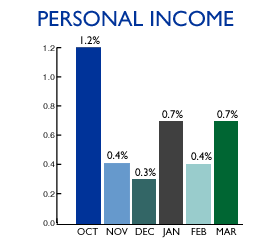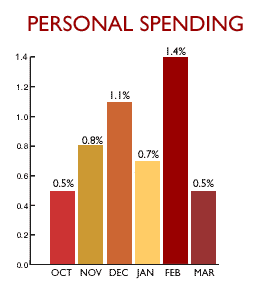|
Income tops spending
|
 |
April 28, 2000: 11:04 a.m. ET
March income levels up 0.7%, spending grows 0.5%; savings rate edges up
By Staff Writer M. Corey Goldman
|
NEW YORK (CNNfn) - The pace of U.S. personal income growth outstripped the pace of spending for the first time in five months in March, while the amount Americans put away in savings rose from a record low, a signal that the Federal Reserve's recent spate of interest rate increases may be starting to have the desired effect.
Separately, the National Association of Purchasing Management-Chicago said its index of business activity slipped slightly in April from March.
 Personal income rose 0.7 percent in March, the Commerce Department said Friday, up from a 0.4 percent increase in February and slightly higher forecasts. Spending rose 0.5 percent, as expected, after a revised 1.4 percent gain in February. The amount Americans put aside in savings rose to a 0.4 percent pace from a revised record low 0.2 percent rate in February. Personal income rose 0.7 percent in March, the Commerce Department said Friday, up from a 0.4 percent increase in February and slightly higher forecasts. Spending rose 0.5 percent, as expected, after a revised 1.4 percent gain in February. The amount Americans put aside in savings rose to a 0.4 percent pace from a revised record low 0.2 percent rate in February.
All told, the numbers paint a picture of U.S. households earning and saving a bit more and spending a bit less, a situation the Federal Reserve has been working toward by raising interest rates five times since last June. Most analysts expect Fed officials will raise short-term rates again at their May 16 policy meeting to slow economic growth and pre-empt inflation.
"Importantly for the Fed, the pace of real consumer spending slowed in March, and combined with early forecasts for lower vehicle and retail sales for April, suggests there is some scope for slower growth in the second quarter," said Steven Wood, an economist with Banc of America Securities. The Fed "will still tighten on May 16, but probably only by 25 basis points," not a 50-point increase which many Wall Street analysts are currently expecting.
Low personal savings
Consumer spending accounts for more than two-thirds of U.S. economic activity and has been one of the principal drivers of the economy, about to enter its record 110th month of uninterrupted expansion.
 Of concern to both Fed policymakers and Washington lawmakers has been the country's low personal savings rate and high debt levels; a combination many fear could spur a crisis should a major slump in the stock market or other economic shock force individuals to pay back what they owe. Of concern to both Fed policymakers and Washington lawmakers has been the country's low personal savings rate and high debt levels; a combination many fear could spur a crisis should a major slump in the stock market or other economic shock force individuals to pay back what they owe.
That's one of several reasons Fed Chairman Alan Greenspan and the central bank's policy-making arm have been raising rates, to discourage consumers and businesses from borrowing more money and injecting that cash into the economy. The Fed is expected to raise its benchmark fed funds rate to 6.25 percent next month, the sixth quarter-point rise in less than a year, though many analysts are factoring in a half-point increase to 6.50 percent.
To be sure, the so-called wealth effect, the recent phenomenon in which stock market and other paper gains have made Americans feel more secure in their outlook, is alive and well, and is expected to continue to fuel spending, according to economists. While stock market declines in recent months have likely tempered the wealth effect somewhat, consumers continue to save very little, a concern for the Fed.
Midwest manufacturing slows
"While it's slightly encouraging, I don't think it's enough to convince the Fed of anything," said Scott Graham, head bond trader with Prudential Securities. "Today's data, while it was somewhat more friendly, is clearly not what I think the Fed is going to focus on."
Incomes in February were lifted by stronger job growth and higher hourly earnings, as well as by additional hiring by the Census Bureau, which has taken on almost 500,000 temporary workers for its latest population tally. Disposable income, or the money left over after taxes, increased 0.7 percent in March after rising 0.3 percent the month before.
Personal spending last month was restrained by a 2.5 decrease in purchases for big-ticket items, particularly automobiles. Spending on non-durable goods rose 1.4 percent and rose 0.7 percent for services. On Thursday, the Commerce Department reported in its first-quarter gross domestic product report that spending rose at an 8.3 percent annual rate, the fastest since an 8.6 percent rate in the second quarter of 1983.
Separately, The National Association of Purchasing Management-Chicago said its regional barometer of business activity slipped to a seasonally adjusted 56.5 in April from 57.4 in March. The prices paid index dipped to 69.4 in April from 74.2 in March. The employment component of the barometer fell to 45.4 in April from 51.4 in March.
Any NAPM index below 50 signals a slowing manufacturing economy, while a reading above 50 suggests expansion. 
|
|
|
|
|
 |

|

